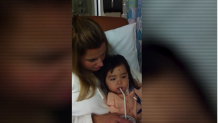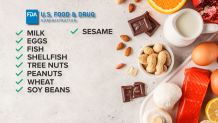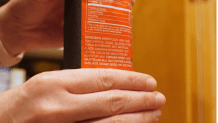Carla Lam knows just how dangerous a food allergy can be.
“I’m always worried,” she said about her 12-year-old daughter, Emma. “I’m always thinking of her.”
Emma has a peanut allergy, one the family discovered after she ate a cookie with peanut butter in it when she was a baby. The treat caused a severe reaction that made Emma critically sick and landed her in a hospital in Miami for over 20 days.
“I learned the hard way what a food allergy was,” Carla said.

'Labels are Confusing'
Over the years, Carla said she has learned to manage her daughter’s allergy and help keep her safe. She always has potentially life-saving doses of epinephrine nearby and always checks out a product’s ingredient list.
“I’ve been 10 years in training already,” Carla said. “I’ve gotten pretty good.”
But trying to figure out if a product is safe for Emma is not always easy.
“Labels are confusing,” Carla said.

Under the Federal Food, Drug and Cosmetic Act, food labels must identify, using its common name, the food source of all major food allergens used to make the food in one of two ways: in the ingredient list or immediately after or next to the list, in a separate “contains statement”.
But there is no requirement to highlight allergens in bold. You can read more about the requirements here: https://www.fda.gov/food/food-labeling-nutrition/food-allergies
That could make it especially challenging to spot an allergen, if someone has several food allergies and the product contains a long list of ingredients. Some companies do put allergens in bold or list them separately, but those are things companies are not required to do.
What's On the Label?

Dr. Vivian Hernandez-Trujillo, a pediatric allergist and an allergy mom herself, said there is room for change that can protect people with food allergies.
“The first thing, I think, that needs to be done is really looking at how we label foods in the United States,” she said. “It needs to become more standardized, and it needs to become more clear.”
NBC6 looked at some of the labels of products Dr. Hernandez-Truijllo had in her pantry.
One pasta product had soy and milk listed in the ingredient list, but not included in a separate contains statement that was on the label. The contains statement only noted the presence of sulfites.
“Somebody could think, oh, something’s highlighted there but it’s not milk or soy so I’m OK and they may have the allergy,” she explained.

The label on a package of cookies we examined had several allergens listed in a separate contains statement, which Dr. Hernandez-Trujillo said was a good example of a label she feels works well. But the label also included a “may contain” statement.
“They put that because in their facility they have certain products with that allergen and they’re concerned with cross-contamination,” Dr. Hernandez-Trujillo said.
That’s why she said in her house, where they deal with several food allergies, they generally don’t eat products that say they may contain one of their allergens.
It’s a strategy Carla follows as well.
“May contain, manufactured, processed – I avoid all of it unless it tells me a peanut or nut-free facility, or just specifies the ingredients and doesn’t specify manufactured or processed in a peanut or tree nut facility,” Carla said.
The FDA told NBC6 those “may contain” or “processed in a facility” statements are not required by law.
The agency is aware of the different advisory statements on food packages and told NBC6 they were in the process of developing a strategy that helps clarify the way manufacturers use those statements.
You can read more about the proposed changes to existing guidance here: https://www.fda.gov/regulatory-information/search-fda-guidance-documents/cpg-sec-555250-draft-major-food-allergen-labeling-and-cross-contact
Resources
A food allergy diagnosis can be scary and overwhelming, but the good news is by preparing and learning all you can about food allergies, you can figure out ways to keep yourself – or a loved one – safe.
Take the time to understand your allergy and how to manage it. Write down any questions you may have before your doctor’s appointment: What is epinephrine? What options do you have to administer it? When should you use it? What are the signs of anaphylaxis?
FARE has a long list of resources that may help you navigate a food allergy diagnosis. Click here to learn more: https://www.foodallergy.org/
FARE also has a sample emergency care plan you can review with your doctor, detailing the signs of a severe allergic reaction and the steps that should be taken in the event of a reaction or exposure to a known allergen: https://www.foodallergy.org/living-food-allergies/food-allergy-essentials/food-allergy-anaphylaxis-emergency-care-plan
You can learn more about food allergies from the Food and Drug Administration by clicking here: https://www.fda.gov/food/food-labeling-nutrition/food-allergies
Red Sneakers for Oakley, a food allergy awareness organization, may also be helpful: https://www.redsneakers.org/all-resources

